IN-DEPTH / IN-DEPTH
Shining a light on China's sea turtle conservation efforts in South China Sea
Turtle paradise
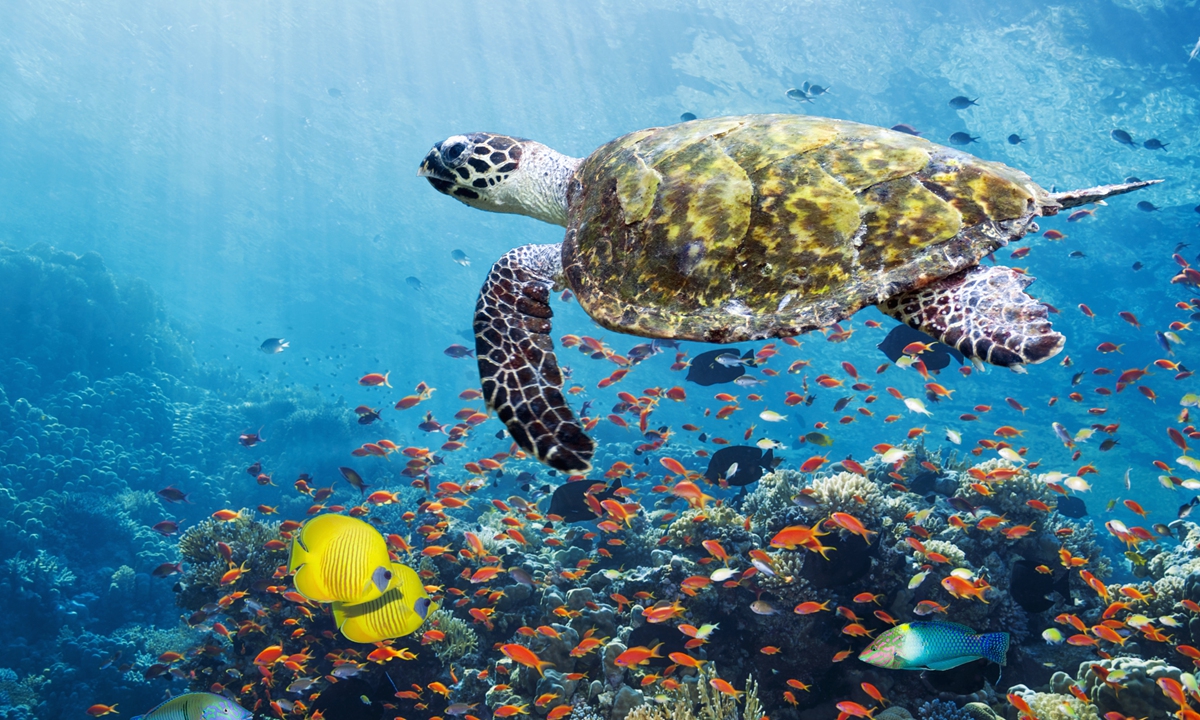
Hawksbill turtle Photo: VCG
Sea turtles, with a history of 160 million years on earth, are truly enchanting creatures. They exhibit remarkable loyalty to their nesting grounds, returning to the beach of their birth to lay eggs once they reach maturity, regardless of the distance. Destruction of their nesting sites can have a devastating impact on their ability to reproduce.
The journey of a sea turtle to lay its eggs is a grueling and treacherous one. From the moment she emerges from the ocean, she must navigate the sandy beach, avoiding predators and human disturbances along the way. With each step, she must dig a deep hole in the sand to deposit her precious eggs, while battling exhaustion and the relentless pull of the tide. Once her task is complete, she must cover the nest and make her way back to the safety of the sea, leaving her offspring to fend for themselves despite the harsh realities of the world.
Of the 1,000 baby sea turtles that bravely embark on their journey into the vast ocean, only a single lucky survivor will have the chance to reach adulthood. The treacherous waters are fraught with peril, testing the resilience and strength of these remarkable creatures.
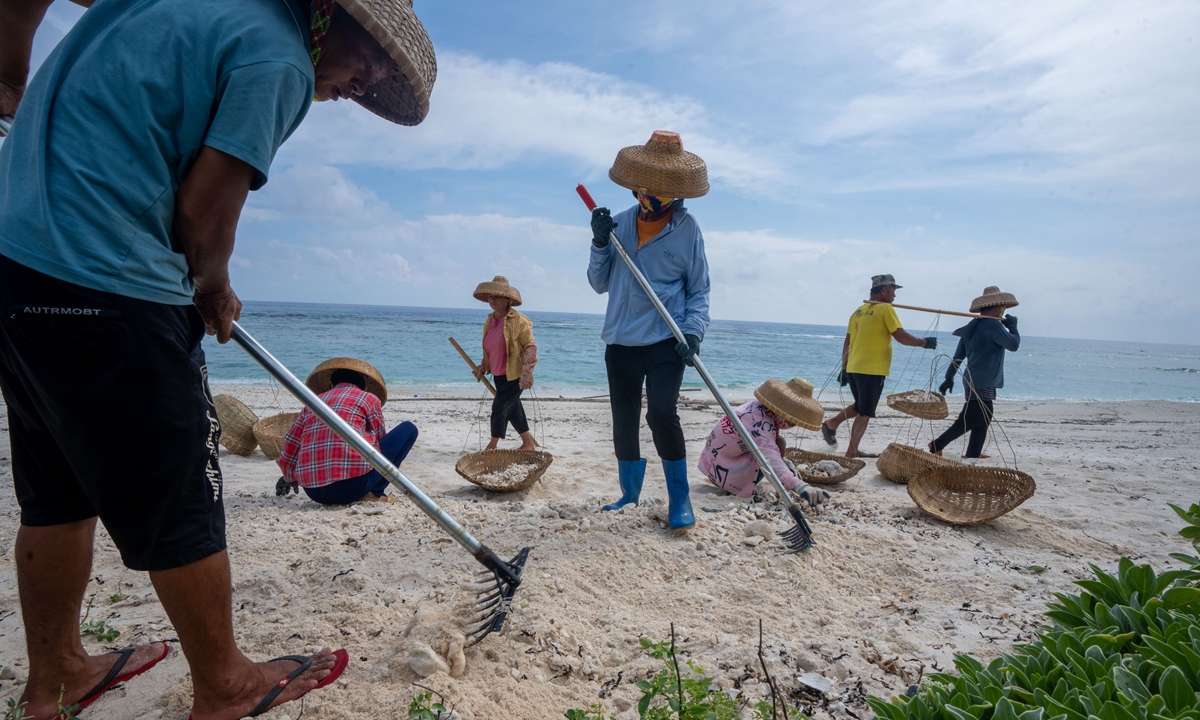
Fishermen in the Beidao Island in Sansha, Hainan, clean up local beaches on September 16, 2023, to create a suitable environment for sea turtles to lay their eggs. Photo: VCG
Currently, there are seven species of sea turtles worldwide, with five found in Chinese waters, including green sea turtles, hawksbill turtles, loggerhead turtles, Pacific ridley turtles, and olive ridley turtles, with the green sea turtles being the most prevalent, followed by the hawksbill ones.
Since the 1980s, due to long-term overfishing, indiscriminate killing, illegal trade, overexploitation, marine pollution and other human factors, as well as the threat of climate change, the global sea turtle population and habitats have decreased.
China has been increasing its efforts to protect sea turtles, with all species now classified as national first-class protected wild animals. Any capture, purchase, sale, transportation, possession, and use of sea turtles is illegal.
In addition to cracking down on the illegal trade in turtles, conservation and rescue initiatives have been strengthened, with the establishment of sea turtle habitat reserves to safeguard nesting sites.
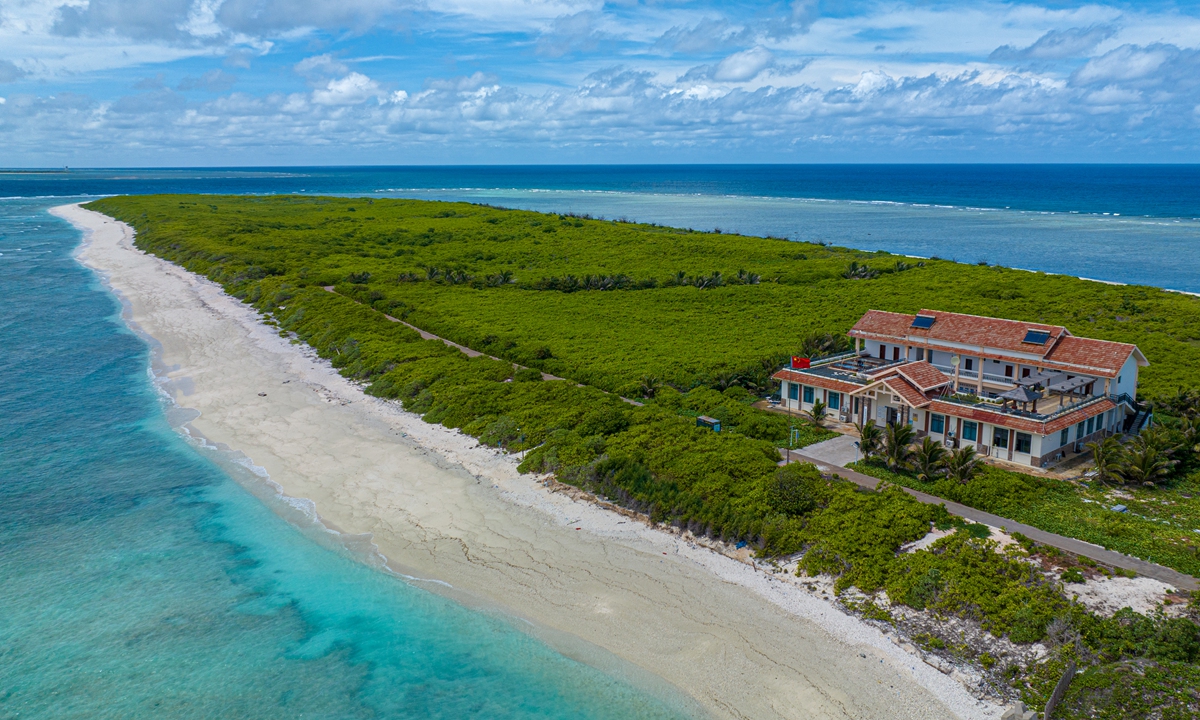
Sea turtle protection center in Sansha, South China's Hainan Province Photo: VCG
Guardians of turtle homes
Latest statistics showed that over the last seven years, a total of 637 sea turtle nests with eggs have been found on Beidao Island, part of the Xisha Islands, accounting for 37 percent of the total in Xisha, the Xinhua News Agency reported in June.
Xisha Islands are an important habitat for green sea turtles. In China, 90 percent of sea turtle population resides in the South China Sea, of which green sea turtles account for more than 80 percent of the total. Beidao is considered to be the largest green sea turtle nesting ground in China.
In 2021, the Beidao sea turtle protection center was established. Scientific research teams from Xiamen University, Sun Yat-sen University, Hainan Normal University, and the South China Sea Fisheries Research Institute of the Chinese Academy of Fishery Sciences set up laboratories or research bases on the Beidao Island, where experts conducted research on the status of the green sea turtle population, sea turtle ecology and conservation biology, according to Xinhua.
Here, local residents nurture naturally hatched baby sea turtles before releasing them back into the ocean, while injured turtles are rehabilitated and returned to their natural habitat by dedicated researchers.
Local residents are also required to participate in patrolling islands and reefs, planting trees, cleaning up sea debris, feeding rescued turtles, and performing various other tasks.
Zhang Ting is a sea turtle researcher from Hainan Normal University, who considers the fishermen on the island to be "local experts" in sea turtles. She told the Global Times that Sansha currently has the largest green sea turtle nesting site in China, where researchers are monitoring the breeding population and habitat of sea turtles.
Zhang mentioned that the fishermen on the island are highly knowledgeable about sea turtles, referring to them as "experts." She observed them closely studying the habits of sea turtles daily and witnessing them laying eggs. These interactions with the experienced fishermen broadened her understanding of sea turtles, prompting her to delve deeper into sea turtle research and publish multiple academic papers on the subject.
Zhang also provided specialized medications and instructed the fishermen on scientifically aiding injured sea turtles. She emphasized the significance of ocean and sea turtle conservation, as well as educating them on ways to prevent unintentional harm to sea turtles during fishing activities.
Zhang noted that academic papers have revealed that marine debris poses a grave threat to the survival of sea turtles, while the impact of global climate change has resulted in a reduction in the available nesting sites for these marine animals.
Chinese sea turtle conservation workers, primarily focused on monitoring sea turtles in the South China Sea, collaborate closely with the Sansha city government to provide advice for the conservation of sea turtles.
"We have observed a significant amount of marine debris near the sea turtle nesting sites. The government of Sansha city has taken proactive measures by mobilizing fishermen to regularly clean the beaches, ensuring a clean and safe nesting environment for sea turtles," Zhang said.
"Additionally, we have encountered challenges during the typhoon season, with some sea turtle nests at risk of being submerged. In response, we conduct timely relocation of sea turtle nests and implement emergency protection measures to safeguard these precious creatures. Our conservation efforts are guided by scientific principles to ensure the well-being of sea turtles," said Zhang.
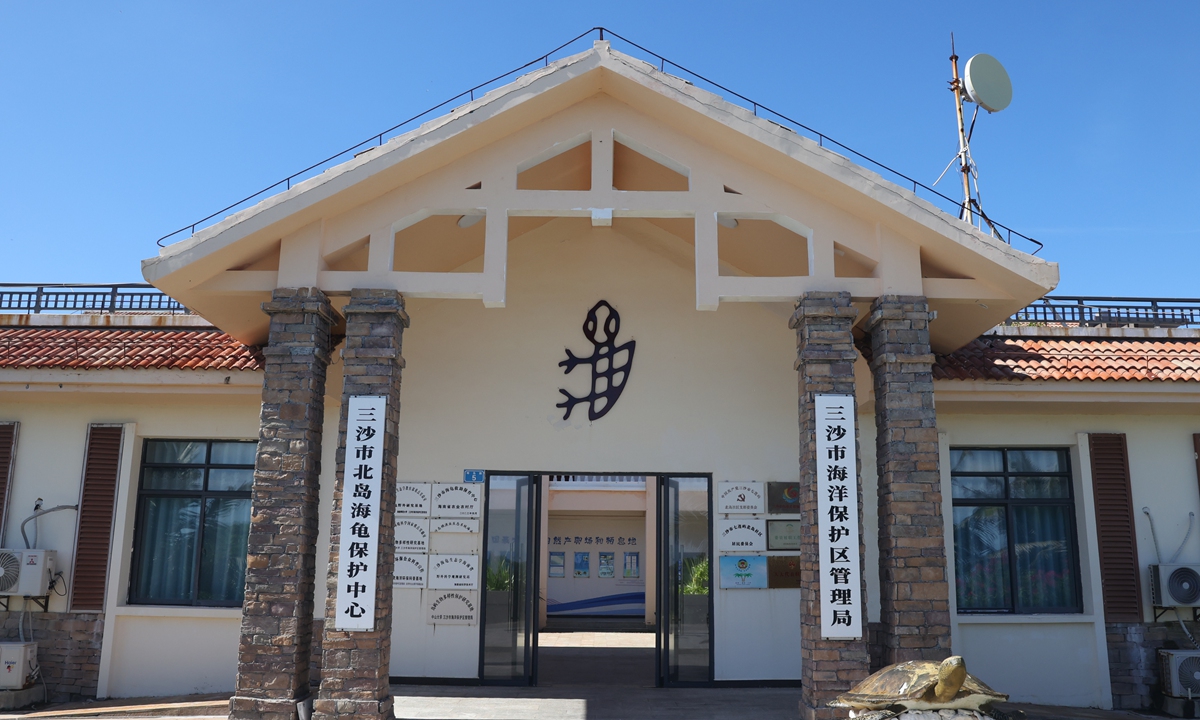
Picture shows the gate of the sea turtle protection center in Sansha, South China's Hainan Province. Photo: Fan Wei/Global Times
Cross-national cooperation valuable
Zhang also emphasized the growing awareness among Chinese individuals, including fishermen operating in the South China Sea, on the importance of protecting sea turtles.
As sea turtles are a migratory species, effective conservation efforts necessitate collaboration not only within China, but also with neighboring regions and countries surrounding the South China Sea.
"Recent monitoring activities have demonstrated the success of sea turtle conservation in China. Many fishermen have reported sightings of sea turtles during their fishing expeditions, and we have captured rare footage of sea turtle mating. Nevertheless, the conservation of sea turtles requires collective action from all stakeholders in the region," Zhang concluded.
The Ministry of Agriculture and Rural Affairs of China announced the Sea Turtle Conservation Action Plan (2019-2033) at the end of 2018. One of the key purposes of the plan is to explore the establishment of a cooperation mechanism for sea turtle conservation with neighboring countries and regions, working together to supervise and protect sea turtle populations and habitats.
International research on conservation and related policies will be conducted, with exchanges planned with countries rich in sea turtle resources, such as the US and Costa Rica. Areas of focus include basic research on sea turtles, population recovery techniques, and habitat protection.
The plan also reiterates that China will actively fulfill international conventions related to sea turtle conservation. This includes meeting obligations under the Convention on International Trade in Endangered Species of Wild Fauna and Flora and relevant resolutions of regional fisheries organizations on sea turtle conservation.
The plan also includes establishing information exchange and joint enforcement mechanisms to combat illegal international trade in sea turtles. The goal is to create a safe and warm home for more baby sea turtles at the sea turtle paradise.
According to official figures cited by Xinhua, after years of protection and ecological restoration, a total of 1,734 nests with green sea turtle eggs were found in Xisha Islands between 2017 and 2023. The sea turtle paradise is expected to provide a safe and warm home for more baby sea turtles.
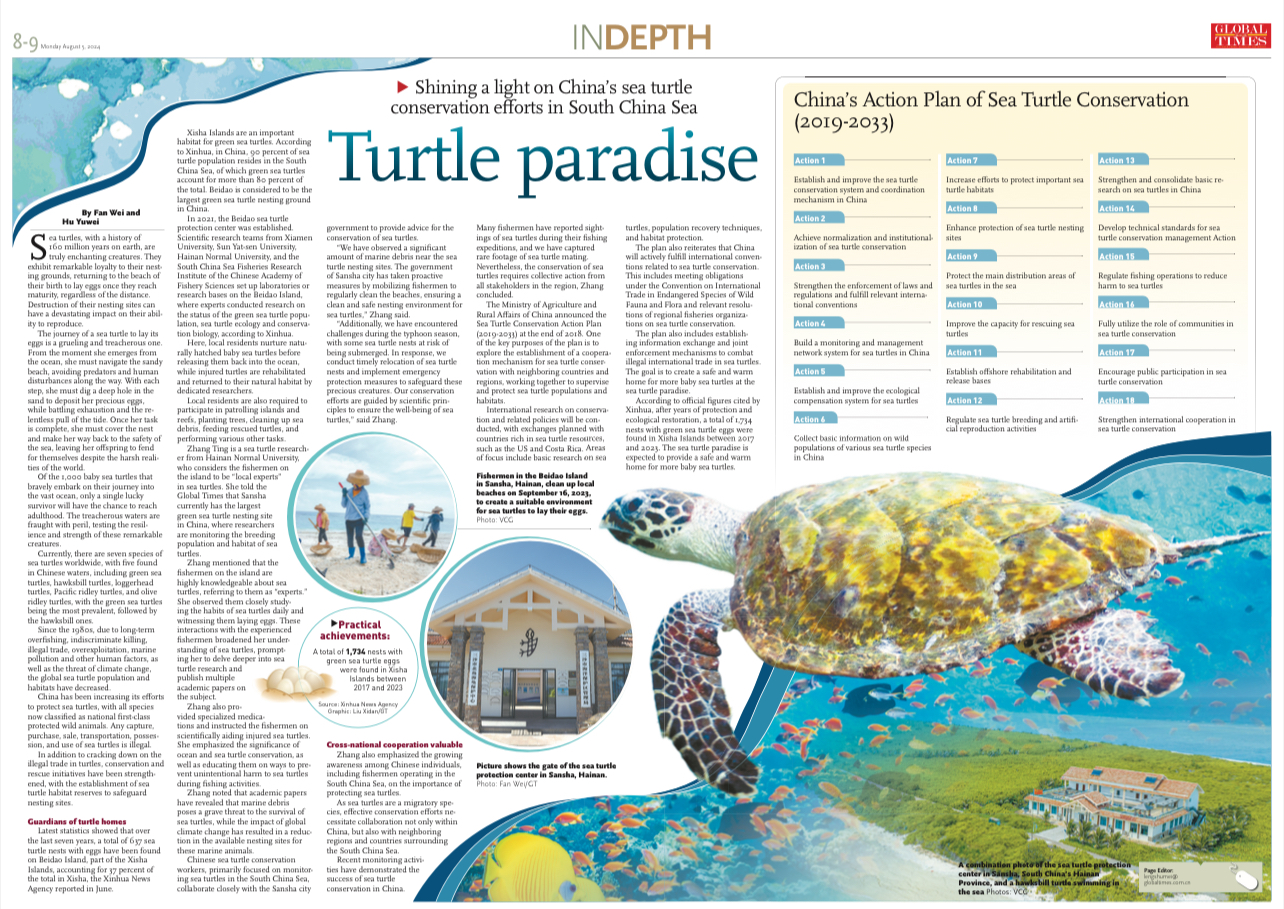
Turtle paradise
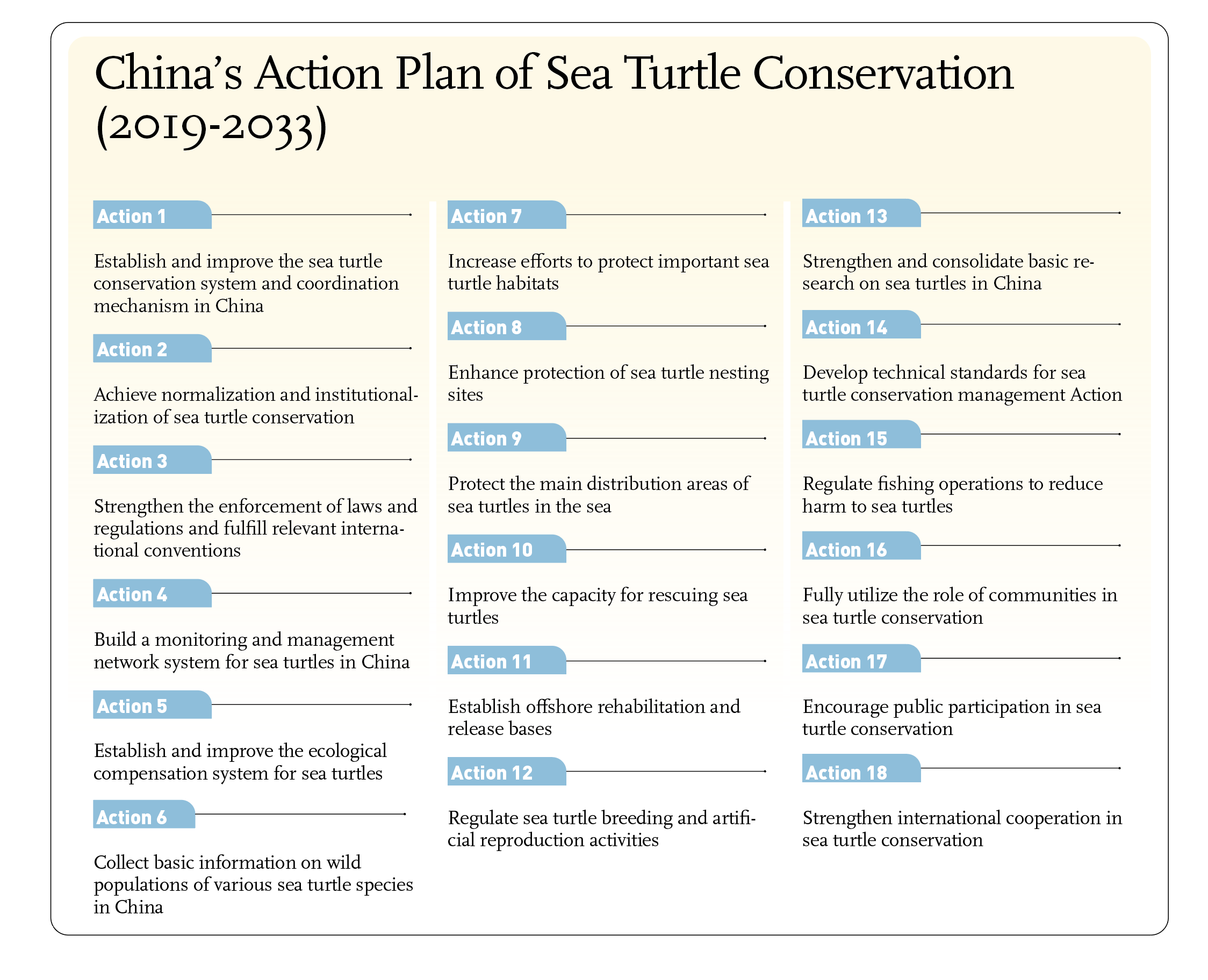
China's Action Plan of Sea Turtle Conservation (2019-2033) Graphic: Liu Xidan/GT




